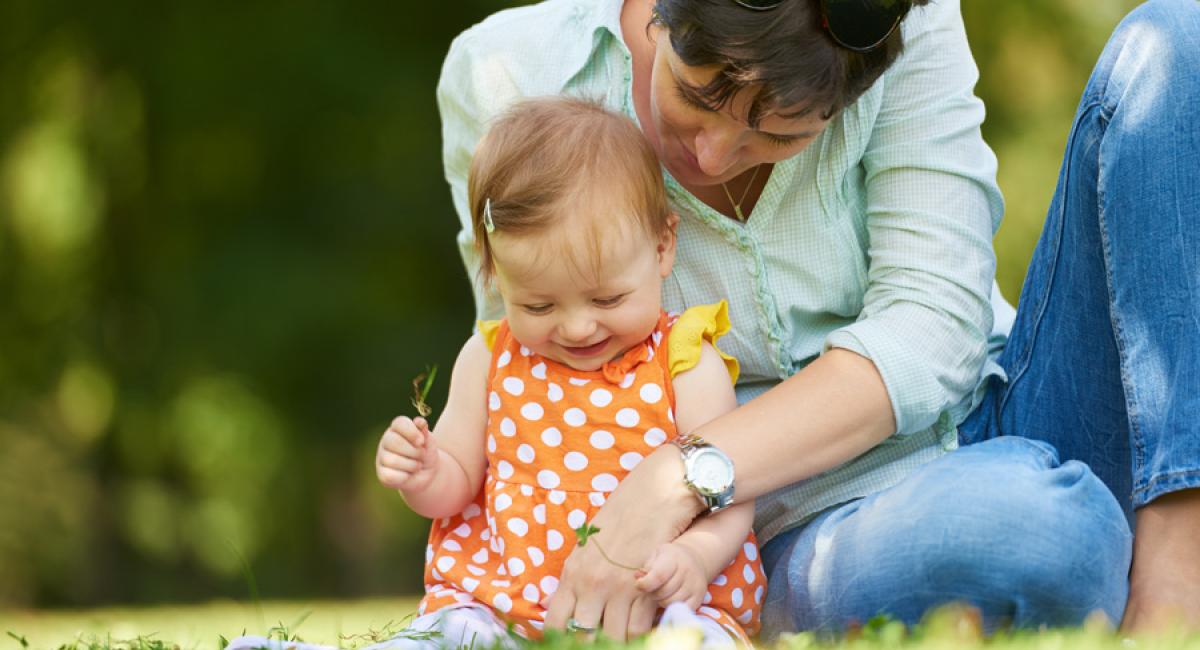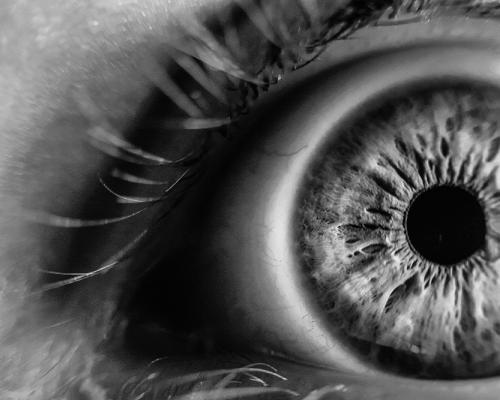Normal birth can be pain free
Sheila Barratt-Smith tells Denise Winn that the images and language used to describe birth can determine whether a woman experiences pain – or euphoria.
Winn: Sheila, I'm looking at a few testimonials from mothers who came during their pregnancies to your GentleBirth classes. This is from Sarah, a petite first-time mum: "My 11lb baby was born at home after only one hour. I didn't need any pain relief or stitches. It was a wonderful experience." This is from Jan: "The midwife who came to assist my delivery said it was the calmest birth she had ever seen." And Maria says, "Thanks for all your support. People are amazed when I tell them I had no painkillers."
Now, as a late mother myself, I had the opportunity when I was pregnant to go to active birth classes and learn all the breathing and different positions that could aid a natural birth, but we weren't ever told not to expect any pain. Yet don't you tell your mothers-to-be that birth doesn't have to be painful?
Barratt-Smith: I tell them that having a baby is a normal bodily function and so it is not logical automatically to expect pain when using a part of the body for the purpose for which it was designed. Pain is a sign that there is something wrong and nothing is wrong with normal birth.
Winn: So how did we end up with this very unhelpful idea that childbirth pain is just about the worst pain you can get, worse than stomach ulcers and kidney stones
Barratt-Smith: Religion played a big part because, by the Middle Ages, the Church had weighed in and denied women help from other women, as atonement for their sins as seducers of men. Once, women in labour were cared for by other women, often their mothers, and their every need was attended to by those they knew and loved. Herbs and aromatic oils were used to soothe, relax and create the gentle atmosphere into which the baby would be welcomed. But, during the Middle Ages, labour assistants — the midwives, homeopaths and aromatherapists of today — were burned at the stake, as witches. Then surgeons decided to take over delivering babies and midwifery started to die out.
So that medical students — all male, as only men were allowed into medical schools — could learn the 'craft', women got brought into hospitals and put into beds, even though they weren't ill, at least at that point. The students would often come straight from dissecting corpses to give the women internal examinations, going from one to another — until Florence Nightingale came along, hygiene was not even thought of. Huge numbers of women died from what was called childbed fever — obviously caused by infection — within 48 hours of the birth. It wasn't till the end of the 1800s that doctors started to realise that the concern that Dr Ignaz Semmelweiss had voiced 40 years before made sense — that poor hygiene was causing infection. But, by that time, the idea of birth as something gentle and joyous had completely gone. Women were terrified of dying in childbirth.
Queen Victoria insisted on chloroform when she gave birth — the first of the "too posh to push" brigade. But it took days for women who had chloroform to recover from the effects of the gas, and who knows how it affected the babies.
Winn: The development of safer anaesthetics was considered a boon by women, unsurprisingly in the circumstances, and, of course, still is today. A lot of women have decided on an epidural while still early on in their pregnancies. But it was an insightful physician called Grantly Dick-Read who realised just how different things ought to be, when there are no complications.
Barratt-Smith: Yes, Grantly Dick-Read was an obstetrician who was born in 1890 and died in 1959. He recognised that the accepted methods of delivering babies, with the emphasis on intervention and anaesthetics, were fundamentally wrong and was author of the bestseller, Childbirth without Fear. He studied how midwives behaved with women in labour, helping them relax, and it was after attending a woman giving birth in the slums of Whitechapel that he first became aware of what he later termed the fear-tension-pain syndrome. He offered the woman chloroform and she refused, so he stood and watched as she gave birth to her baby in silence, with only gentle breathing. Afterwards, he asked her why she had refused the chloroform and she said, "It didn't hurt. It wasn't meant to, was it, doctor?"
That was quite an eye-opener. He soon recognised from his experiences in the slums of the East End that fear and anxiety produced tension in a labouring woman and, in turn, that tension produced pain. Unfortunately, his ideas were seen as ridiculous and he was booted out of the London clinic that he had set up with some fellow obstetricians.
So what is the difference between us today and those women in the slums all those years ago?
Even women in the villages of Africa and India seem to have much easier births than we do. Can you remember the woman in the floods of Bangladesh who gave birth up a tree? So why are our experiences here so bad? Our bodies are the same; the only difference is our thoughts. Whereas women once looked upon childbirth as a beautiful, peaceful event, we have now come to see it, in many cases, as a long-drawn-out battle.
Winn: Yes, women do love recounting their dreadful births!
Barratt-Smith: Absolutely! Horror stories told by our mothers, family, friends, colleagues, health professionals and even total strangers, or overheard as girls, and then reaffirmed by images on TV of women screaming whilst giving birth, and sessions in antenatal classes on available methods of pain relief — they are all guaranteed to programme our minds with a negative picture of birth. The message that comes across loud and clear is: "Childbirth is painful". These stories are an accepted part of mother and baby meetings; they go very well with a cup of coffee and a biscuit. Aristotle gave us a vital clue all those years ago, when he said, "The mind of a pregnant woman needs to be cared for". Yet in many pregnancies today that is a far cry from what happens.
Winn: I remember being told that pain in childbirth was something to do with the size of human babies' heads – that is, they became bigger, to house our larger evolved brains, and were no longer well adapted to the birth canal. But then there is also the theory that we are especially immature when we are born because we have to be born at an earlier stage, while the head can still be got out.
Barratt-Smith: Unless something is wrong, a woman's body can manage to give birth to a baby, whatever size it is. There is a perception that the bigger the baby the harder the birth. But that isn't right. The baby's head moulds to the shape of the body. My own daughter had a traumatic first birth and swore she would never have a baby in hospital again. I had started my birthing courses by the time she was pregnant the second time and so she and my son-in-law came along. Alice is only 5 feet 3 inches and weighs just eight stone and she had what is called a posterior presentation — baby's back to her back.
Winn: Ah yes. What pregnant women are warned will be a bad 'backache labour'.
Barratt-Smith: Yes, that is what they are told. Alice had already had to fight for a home birth, being told a week before the birth that she couldn't have one, but she insisted. The community midwives who attended were very supportive and it wasn't until she gave birth that she found out the baby was back to back. She used the breathing and visualisation techniques we had practised and walked a lot, remaining very calm. The midwife who was present couldn't believe it. She said that usually women with a baby in this position would be screaming for an epidural. What's more, the waters stayed intact. I was told once by an independent midwife that the amniotic membrane doesn't have to break before the birth; it protects the baby and cushions the baby's descent down the birth canal. Indeed, the baby of one of my couples, who gave birth at home, was born with the membrane still intact.
Winn: That's very interesting.
Barratt-Smith: In Alice's case, the midwives suggesting breaking the waters so that the birth would occur sooner, as they felt she was getting tired. Ten minutes later, little though she is, she gave birth without any problem to a 9lb baby boy. I saw his head as it came out and what happened was amazing. Because the baby was the wrong way round, his head was like the cone of a rocket. But it sprang back within a second. It you weren't watching, you would have missed it.
Babies are aerodynamically designed to be born as easily as possible. It is not in their interests, or the mothers', to have a difficult birth.
Winn: Well, that makes a lot of sense and you never actually hear that said. So is it the fear–tension–pain syndrome that stops it happening?
Barratt-Smith: Yes. Many women today, once they have recovered from the initial euphoria of finding out they are going to have a baby, can become highly anxious about what they think the birth is going to be like. The problem is that fear and anxiety set off the flight or flight response in the body. A woman needs to feel safe and secure, just like an animal does, before she can give birth. In an animal, fear usually means that its life is in danger. So if an animal that is about to give birth feels endangered, the birthing process is suspended until it feels completely safe. It may need to take action first to save its life.
The effect of the fight or flight response during birth is to direct all the oxygenated blood to the arms and legs, away from the uterus and the baby. When nothing life endangering is actually happening, there is no action to take and the baby and the mum are both just left stressed. If this happens at a late stage, a woman may be told that the cervix is stuck and that baby is in distress, and needs to be born quickly. That means more stress for the mum and even less oxygen for the baby — horror, trauma, screams, panic and finally an emergency caesarean.
Or it can happen at an early stage. How often do we hear of women who go into labour at home and are getting along quite well and progressing nicely, and then they are advised to go into hospital. They get there and perhaps it is a busy night so they are put into a side room and left to get on with it by themselves. It is an alien environment. The fight or flight reflex responds to this situation and the freeze part of it kicks in. The contractions suddenly stop in response to the perceived danger. Sometimes the women get sent home again or sometimes they end up being induced, to move them along, but the anxiety has already set in. Aristotle said, "Nature does nothing uselessly" and how true that is of giving birth. Everything that we need to give birth easily, comfortably and safely is at our disposal. Our bodies are like finely tuned instruments and, given the right frame of mind, will perform perfectly. But today, everything seems to be designed to stop us doing that.
Aristotle gave us a vital clue all those years ago when he said, "The mind of a pregnant woman needs to be cared for."
Winn: It is interesting that you mention the need for safety because, as we know, that is a basic human need. And, when I heard you speak about your work, you quoted champion of natural birth Dr Michel Odent, when he said, "There is a basic need for mammalian privacy. For decades women have been told they need a guide to tell them what to do and when to do it. To give birth, women must release the hormone oxytocin, and it is a shy hormone. If there are people around it doesn't appear."
Barratt-Smith: Exactly. In the normal scheme of things, a woman about to give birth is going to feel most safe if she can do so in private, when someone she loves and who loves her is around her and soothing her (her partner, close friend or her mother), rather than a possibly previously unknown midwife fussing around with monitors or an obstetrician being very medical. When birth is the experience it should be, it can be a very sensual experience and a woman will want to move in accord with the energy in her body. It is for this reason that, in Russia, the natural birth movement teaches belly dancing. But you don't want to be watched by strangers, however well meaning, when making those intimate kinds of movements. So a woman is more likely to feel uncomfortable and clam up.
Winn: Can you say some more about oxytocin?
Barratt-Smith: Dr Michel Odent describes it as a cocktail of love hormones released during labour! It makes you fall in love with your baby. There is a theory that so many American children are aggressive and out of control these days because so many mothers are having caesareans. Apparently, if chemical oxytocin is given it prevents the release of natural oxytocin. So, as there is no flood of oxytocin and often mum does not get to hold baby immediately, bonding between mother and baby is a problem. Oxytocin acts on the uterine muscles and helps them work in harmony. The ligaments soften so the pelvic bones can click out a bit to let the baby through. You could say that oxytocin allows the horizontal muscles to go floppy and stop holding baby in, while the vertical ones work to nudge baby down from behind.
Winn: Now, that's important, isn't it — the way you explain to women what is happening during the birth process — words like 'imagine the baby wriggling its way down the birth path' and 'sensations'? You never use the word 'pain'. And that is clearly a good idea — otherwise women will pattern match to pain.
Barratt-Smith: That's right. But midwives are taught that the vertical muscles 'squeeze' the baby out. The 'pain' of it tells them that the contractions are coming properly. And the lull between is supposed to tell them that the muscles are relaxing again. Now, that doesn't sound very comfortable! I say to my mums-to-be that the muscles work together in harmony to open the space to let the baby out and nudge the baby down gently.
Winn: That creates a very different picture.
Barratt-Smith: Unfortunately, because midwives expect women to be in pain, and for the pain to increase as the cervix opens further, sometimes they actually don't realise when a Hypno-Birthing® mum is ready to give birth! One young woman, Sarah, a second-time mum who did my course because of an awful first experience, was told she needed to be induced because she was overdue. Now that is another thing. A baby is perceived to be overdue at 42 weeks. But scanning is not totally accurate and can be out by two weeks and weight can be under- or overestimated by 2lbs. More importantly, the due date was established 150 years ago by a German obstetrician called Franz Karl Naegele, who used historical rather than observational data. So it doesn't take a mastermind to realise that this could do with updating. Yet many mums-to-be will be persuaded to be induced, a painful way of giving birth, when they don't need to be. This is what happened with Sarah. She was only 22 and when you have professionals insisting they know what is best for you in the circumstances, it is hard to stand against them.
The midwives put her to bed and gave her the artificial form of oxytocin that is used to start labour going. Then the ward got busy and they forgot about her. So she decided to listen to her relaxation tape and go to sleep. She felt a few twinges, thought they were Braxton Hicks [false contractions] so went back to sleep. When she woke up eight hours later, she knew she was ready to give birth. But the midwives didn't believe her. They just insisted she couldn't be ready and they would need to get her to a delivery room first, when she was. She was ignored a few times. It was only when her mum, who was training to be a midwife herself, came to see her, had a look and saw the baby's head that she was finally taken seriously. The midwives couldn't believe that Sarah wasn't in any pain.
Winn: That's astounding! Tell us a little about the courses you run. As you've mentioned, certainly some of the women who attend are there because of horrendous first births and they want things to be different.
Barratt-Smith: Actually, most of the women who attend my courses come because of bad experiences or sky-high anxiety — or else they are first-time mums looking for a good experience.
Winn: How do you turn around those bad experiences so quickly, so that fear and tension turn to confidence? After all, as we know, some women literally are traumatised by the birth they have had and suffer post-traumatic stress symptoms. Do you need to deal with that first — for instance, by using the rewind detraumatisation technique?
Barratt-Smith: The course is specifically designed to help the mum- and dad-to-be understand the physiology of birth, how language and your thoughts affect you and why there is no logical reason for pain to be an automatic part of birth – if you can't change the event then the only possibility is to change your thoughts about it. This generally has the desired effect, although I have used the rewind technique on a woman who had been through a particularly traumatic caesarean, and I do what all good human givens counsellors do – I give women hope in the very first session that things can be different.
The GentleBirth course, using HypnoBirthing®, runs for four three-hour sessions on a Saturday. The dads-to-be or birthing partners are an integral part of the course. What we aim for is the best and safest birth possible, according to individual circumstances. I would never promise a pain-free birth and I am very clear about that; the emphasis is on explaining how the muscles of the body work, changing the language and changing the focus so that the expectations are of being in control and having a more comfortable relaxing experience. We never want to set up unrealistic expectations. For this reason part of the course covers what to do in 'special circumstances' — complications to everyone else.
What I teach, in line with what Grantly Dick-Read taught, is that, if pain is not caused by fear and anxiety, then something is wrong and needs to be taken care of. Sometimes medical intervention is necessary and so we look at how to make the right choices in those situations. Caesareans can and do happen but mum and baby can still remain relaxed. One mum had a caesarean because she was told the midwives weren't experienced enough to attend a breech birth. But she recovered much more quickly than other mothers who had had caesareans because she remained calm and her baby was very relaxed. I saw her and her daughter a month ago and everyone says what a calm, contented, happy one-year-old the daughter is.
Winn: So what is the first thing you do to start to change women's minds about the expectation of pain?
Barratt-Smith: I explain the fear–tension–pain connection. I explain how the fight or flight response diverts blood to the wrong places — to the arms and legs so that they can take 'survival' action — instead of to the uterus, which needs it for the job in hand. And the women all relate to the idea that labour can come to a halt on arrival in hospital, either because they have been through it themselves or know someone who has — it is so common.
I tell them a bit of the history of childbirth, as much as I've told you, and how a natural process was medicalised and made painful. And then we start to change the language. If you tell a woman that birth doesn't have to be painful, she equates this with feeling nothing, as with an epidural, — and that is not true. So we talk about the labour 'sensations' she will feel, such as pressure or tightening, and describe contractions as 'surges' or 'waves'. I talk about other sensations in our bodies that we are used to feeling and responding to on a daily basis. We instinctively know how to do what is right. When we feel hungry, we eat — it can be a pleasant sensation when we know we can have food but an unpleasant one when we can't. Similarly, when we need to empty our bodies of waste products, we just go to the toilet — and feel uncomfortable only if we can't.
In human givens terms, we 'normalise' and 'reframe'. When women understand how their bodies work — the role of the uterine muscles, for instance — they can help the contractions along, making them shorter and more effective. When they stay attuned to their bodies and the sensations they are experiencing, they know instinctively which way to breathe at the different stages.
Winn: Is this something you teach them?
Barratt-Smith: Yes. It's called 'sleep breathing'.
Winn: Is that the same as 7/11 breathing?
Oh, we don't do pushing! If you push, you actually close the cervix, instead of opening it.
Barratt-Smith: Same principle, yes, but I have women breathe in to a count of 4 and out to a count of 8. That teaches them to relax — which they have often never done before. Balloon breathing, a specific type of breathing, different from 4/8 breathing, takes them through the contractions. But when birth is imminent, a woman will want to breathe in a different way — it is what is called 'birth-breathing'. They do this by directing their energy and their breathing behind the baby.
Winn: Do they do that while pushing?
Barratt-Smith: Oh, we don't do pushing! Did you know that, if you push, you actually close the cervix, instead of opening it? Pushing causes tension, is hard work and uses a lot of energy. It is a matter of changing the breathing to achieve the same effect. Of course, my mums-to-be say to me, “But how will we know when we need to change our breathing?” And I say, “Trust me. You will know.” And they do. They go with their body sensations and they are relieved to relax and surrender, rather than struggle to control. Birth movements and birth positions come naturally in the course of a surrendered birth. And post-natal depression is very unlikely after this sort of birth. The amount of endorphins released and the sense of achievement, in such circumstances, keep new mothers on a high for a long time afterwards.
I have personally seen all this, at home births and on DVDs, and I just wish I could have experienced it for myself! Unfortunately, when I gave birth, it was when you were still shaved and given an enema, then told to have a shower, and then made to lie on your back and give birth uphill. I had been fine at home but I absolutely lost it once in hospital; they took my control away and I nearly ended up with a caesarean. But I had always known my births could have been different, which is why I was drawn to run these courses.
The muscles work in harmony to nudge the baby down gently.
Winn: As I mentioned, I was luckier and, as a health journalist, I had written a lot about natural birth so that, by the time I got pregnant, that was what I hoped for — and luckily got, although it was certainly by no means pain free either time. I didn't expect it to be, come to think of it, because I had never received the message that it would be. But I did know of people who did think that they would float through it all, if they diligently learned their breathing techniques and practised their squatting. Then, when their contractions started, they were suddenly completely overwhelmed and, because this was contrary to their expectations, were even less able to cope. They lost it completely and often had the works, in terms of anaesthesia.
Barratt-Smith: Well, what you focus on is what you get and what you have in your mind transfers itself to what is going on in the body. Just because you have a healthy body doesn't mean that you automatically know how to give birth and, with all the negative images, it is no surprise that women end up in pain. Also, because of words like 'labour pains' they are still focused on pain. Perhaps they were thinking beforehand, “I can beat the pain”.
Winn: I think they probably were.
Barratt-Smith: So, immediately there is struggle. And then there is the hidden anxiety: “Will I really be able to cope?” As we know, the sensations of excitement and anxiety are pretty much the same. When there is genuine curiosity and anticipation — “I wonder how it is going to go?” — the sensations are very different from when we have anxiety and dread.
Winn: That makes good sense. What else happens on the course?
Barratt-Smith: Well, interestingly, part of the course addresses the fears and anxieties of both the mum- and dad-to-be. At the end of the second session they are asked to go away and write down any fears or anxieties they have about the pregnancy, the birth or after baby has arrived. The most amazing thing is that, although at the beginning of the course the main topic is pain, the worries have changed completely by the end of the second session. So when, in the third session, we get to discuss them, I find that the women have concerns about how they will look after a baby with an existing child, or what it will be like to go back to work and leave the baby, and the dads-to-be are wondering whether the car will be big enough. Not a thought or mention of pain.
Winn: I am sure that, as a clinical hypnotherapist, you work a lot with visualisation. Do you get mothers to imagine wafting off to some pleasant beach during labour, and so on?
Barratt-Smith: We do a lot of visualisation and it would work, of course, in terms of relaxation, to imagine being on a beach. But what I am teaching is that the mother and baby work together. So they very much want to stay focused on the baby and in touch with their sensations. They tend to choose to imagine a balloon image for the birth canal, creating more room for the baby to come out, and concentrate on seeing the baby wafting down it safely.
The GentleBirth course totally changes their perspective of birth. The mums go from stressed to relaxed, sleeping well even at the end of their pregnancy. They have more energy and confidence and look forward to giving birth. The change in them is amazing.
Winn: You said you like partners to come to the course as well. Do you think they have a useful role to play or do they try to take things over and run the show?
Barratt-Smith: I think they have a vital role to play! Often dads are anxious bystanders, watching the birth play out before their eyes, sometimes feeling like spare parts or just not knowing how they can help — and transferring their anxiety to their partner.
But these days maternity units are large impersonal places. The system dictates that a labouring woman is attended to by strangers. Midwives do their best to make things as comfortable as possible for women giving birth, but they have to conform to hospital protocol. So the dad, or other birthing partner, is often the only known face, and it is a fitting role that he should be the one who can protect her and give her the security she needs to be able to give birth.
Birth is not a mental process. It is instinctive and the mum-to-be cannot think clinically during her birth. We know that, generally, women are very good at multitasking and men are good at being single minded. This is the one time in their lives when they benefit from swapping roles. During birth a woman needs to be totally focused on herself and her baby. For the dad-to-be, it's a case of doing everything else — seeing to his partner's every need, from food and drink to communicating with those present at the birth. A woman often doesn't feel listened to in hospital, as I've explained. The dad can listen and make sure that whoever needs to know hears. This is a practical role and brings an enormous sense of satisfaction, so dads can actually feel part of the birth and, as a result, much closer to their baby.
I think that, as with conception, birth is an intimate joining of male and female energy.
Winn: How do you explain the transition stage, as it is known, when the cervix is fully dilated and the mildest-mannered women are often said to start swearing like troopers at their dearly beloved and wish they had never got pregnant in the first place?
Barratt-Smith: Ah, transition. We are told, aren't we, that that is the hardest and most painful bit and we hear horror stories like the one you've just told? But transition just means the baby is ready to be born and the woman needs to breathe a different way.
Winn: You said wisely at the start that it is not in a baby's interest for their birth to be difficult. We know that babies can be born addicted to drugs, if their mothers are, or be affected by alcohol intake. What, if anything, do we know about the effect on a baby of a mother's emotions during birth? We certainly now know that anxiety during pregnancy can adversely affect the cognitive development and behaviour of young children.
Barratt-Smith: It is a good question. There is some evidence — I think it is in the Secret Life of the Unborn Child by Dr Thomas Verney — to suggest that whatever the mum goes through the baby goes through during birth. When a baby is induced, we know that contractions are very strong and extremely difficult for mum to cope with. Imagine, then, that same pressure on the baby. When mum gets stress hormones, so does baby. When she is in pain, is the baby suffering too? Peter Jackson, a registered nurse, was quoted in the HypnoBirthing® book as saying, “A pregnant woman is like a beautiful flowering tree, but take care when it comes time for the harvest that you do not shake or bruise the tree, for in doing so you may harm both the tree and the fruit.”
Winn: Powerfully put. You mentioned earlier some midwives who didn't know how to deliver a breech baby. And I saw an American film clip in which four young midwives, sitting in a row, were asked how often they had attended a natural birth. There was absolute silence and their faces were blank and then embarrassed smiles started to lift the corners of their mouths and one giggled, “Never!” Do you think it is getting harder and harder for mothers to get the births they want, even though our government has called for an increase in home births now?
Barratt-Smith: Well, that's rhetoric, isn't it? How can they if they haven't enough midwives to take the responsibility for doing them? In the UK, midwives apparently have an obligation to attend a birthing mother wherever she wishes to give birth. In the early 1990s, the House of Commons officially mandated that the needs of birthing women be the central focus of the healthcare providers and that maternity services be fashioned around them, not the other way round — unfortunately, this still is not the case. But the NHS could save a lot of money if there were an increase in home births because the caesarean rate would drop considerably. Midwives will tell you that the longer a woman stays at home when giving birth the less likely she is to have medical intervention. In America, they have a 46 per cent caesarean rate and the second highest newborn death rate in the developed world, but, then, birth there is a billion-dollar business.
Here, birth is a postcode lottery. If you live in one area, you may be told that you are not allowed a home birth, or you need a caesarean if your baby is breech. When asked at a conference on normal birth what qualities make a good midwife, one midwife offered the suggestion, “Being able to drink tea intelligently”. That sums it up so well. By sitting calmly drinking tea, they convey confidence in a woman's ability to give birth without unnecessary assistance, but they use their intelligence and skill to judge if and when there is a need to intervene.
Winn: I know you give a lecture on 'normal birth' twice a year to student midwives at Worcester University. Are you starting to change expectations?
Barratt-Smith: It goes down well but a lot of midwives have set beliefs that are difficult to shift, as yet. But I'm hopeful. I have just put together, with the help of Mia Scotland, a practitioner in Nottingham, a workshop for midwives, at which I plan to show videos of these births. Whenever midwives see these, they can't believe the women are having contractions. But the women are clearly giving birth!
I think, for a baby, birth is like going on a journey. Imagine you are going somewhere exciting, new and unfamiliar and it is going to be quite demanding when you get there. If you could choose your method of transport, would it be a crowded tube train where you are pushed about and squashed; you're too hot or too cold; it's too bright and too noisy; and maybe you even have a panic attack thrown in for good measure, arriving stressed and with a headache? Or would you choose a Bentley? Luxurious seats, soft music, some light nourishment of your choice along the way; a chance to rest comfortably if you get tired, arriving at your journey's end feeling refreshed, relaxed and ready to begin your new experience? I know which one I would choose — and it's the same for a baby.
This is an edited version of the article which first appeared in "Human Givens Journal" Volume 15 - No. 4: 2008
 Spread the word – each issue of the Journal is jam-packed with thought-provoking articles, interviews, case histories, news, research findings, book reviews and more. The journal takes no advertising at all, in order to maintain its editorial independence.
Spread the word – each issue of the Journal is jam-packed with thought-provoking articles, interviews, case histories, news, research findings, book reviews and more. The journal takes no advertising at all, in order to maintain its editorial independence.
To survive, however, it needs new readers and subscribers – if you find the articles, case histories and interviews on this website helpful, and would like to support the human givens approach – please take out a subscription or buy a back issue today.
Latest Tweets:
Tweets by humangivensLatest News:
HG practitioner participates in global congress
HG practitioner Felicity Jaffrey, who lives and works in Egypt, received the extraordinary honour of being invited to speak at Egypt’s hugely prestigious Global Congress on Population, Health and Human Development (PHDC24) in Cairo in October.
SCoPEd - latest update
The six SCoPEd partners have published their latest update on the important work currently underway with regards to the SCoPEd framework implementation, governance and impact assessment.
Date posted: 14/02/2024












